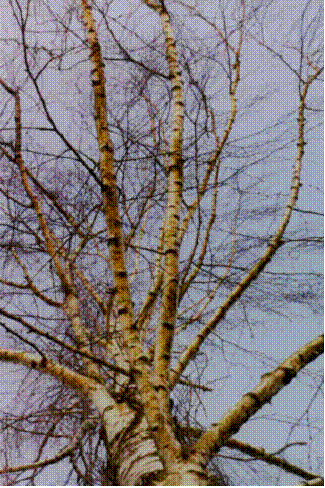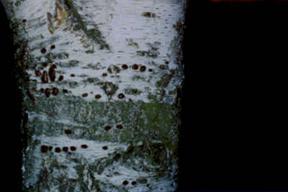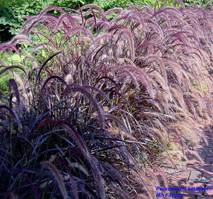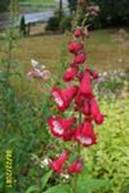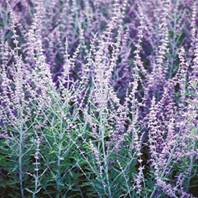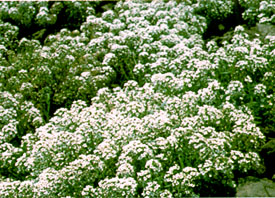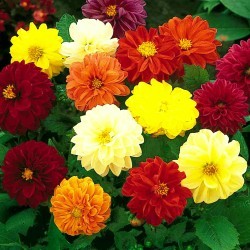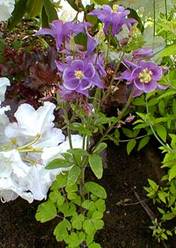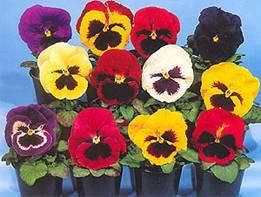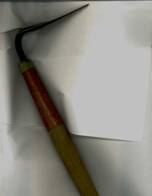Garden Site Description
Step #1
Site Location: Nestled in the center of the driveway, the garden that I will be nurturing for winter and spring quarters is located at my home in Rochester.

Description of Area: Currently, this garden area is overrun with unwanted greenery. Chickweed, dandelions, and an assortment of grasses cover the rich earth like a quilt with squares now encroaching on the gravel driveway. Although the green of the area is easier on the senses than the dry yellow of summer, I strongly yearn for a sense of order within the space. As I sit surrounded by the large, smooth rocks bordering the garden, my dogs pass through the bed churning upward the fragrances of the resting community below their paws. Surprisingly, I do not smell winter, but rather I smell spring. The crushing of the green leaves produces a subtle, fresh scent, and the soil excites my nostrils with the invitation to dig deeply with my bare hands. The consistency of the loam feels tantalizing against my skin. While I witness another beautiful sunset, I hear the cowbirds coming home to roost in the windbreak of Douglas fir across the yard from me. The last remaining bird soars into its shelter for a night of rest and motions me to do the same.
Description of Site
Size: At the bed's widest points, it measures 26' x 37'.
Shape: The bed is primarily a circle with dimensions that are not entirely perfect, since the final shape of the bed was determined by the operation of our motor vehicles. The raindrop shape was created by making the bed as big as it could be while still remaining small enough to comfortably drive a car around � hence, the circular driveway.
Topography: This garden area is not raised in a traditional sense, but I cannot describe it as flat, either. The surface of the garden is smooth with no hills or valleys.
Slope: Because of the large birch tree in the center of the bed, I was unable to dig deeply into the soil for amending, so rather I built a well for the tree, and raised the soil level with three consecutive years of a thick three to six inch layer of compost. The bed now slopes gently in all directions from the tree well out to its river stone border.
Exposure: The garden site receives approximately eight hours or more of sunlight in the summer months with the east portion of the bed receiving slightly less. During the winter season, sunlight is distributed evenly, since the birch sleeps naked, no longer lending shade but merely a silhouette upon the ground.
Soil Characteristics: Lusciously colored like dark chocolate, the loam soil drains well nevertheless retains adequate moisture for plant roots to absorb. A fistful of earth balls in the hand yet crumbles effortlessly when pressure is applied.
Water Features: A tattered, resin birdbath attracts birds seeking a stage for performing their personal hygiene rituals.

Evidence of animal activity: The European Weeping Birch has an area bark where rows of holes expose the underlying wood. One day this past summer, I sat in my driveway watching a �Red-naped Sapsucker� ( Sphyrapicus various ) create some of these holes. I appreciate my feathered friends' efforts in keeping my tree healthy.
Principal Plant Species present: All abundant plant life must be considered weeds since I did not plant them and wish they would just go away forever (at least in this area). Categorizing them as healthy and robust would be considered an understatement by my family who has coined the phrase �Jurassic Weeds�. In the past, I have had weeds that experience tells me should only get a foot across and a foot tall reach four feet across and three feet tall. Glory be to compost!
Plants that reside above ground during winter are few. I planted a euphorbia from Heronswood Nursery in the late summer of 2003. Its burgundy foliage rises and spreads on two feet stems. A mystery plant transplanted from my father's garden behaves like a euphorbia but has purple, aster-like flowers in summer. Finally, a green, dwarf conifer rests alone in the northeast area of the garden bed and looks a bit sad. Irises are beginning to awaken and have stretched ever so slightly above the soil surface.
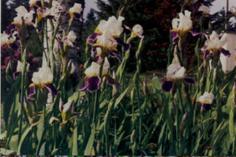

My History with the Site: As I drove through the gate for the very first time, the birch in the center of the driveway welcomed me. Five years ago, its bed was a triangle bordered by a country fence made from landscape timbers and cinder blocks. The only companion plants remaining from the original bed are beautiful iris that have only bloomed once. My husband and I have reshaped and resized the center bed three times giving it better scale in relationship to the surrounding features.
Feeling about the Site: Last year, this garden area suffered with many other areas of my yard. I lacked ambition, dedication, and passion for my property. I was overwhelmed. Currently, the bed is a canvas to be wiped clean and repainted into a humble masterpiece. It is a starting point for many gardening adventures to come. I am excited to have begun the process of creating and nurturing my immediate environment. In my dreams, I see lush plants growing together to choke out the weeds and creating a tapestry of various textures and colors to arouse the senses.
Drawings

Plant and Feature Key
Taken from garden bed drawing
The most prominent feature of my garden bed is my weeping birch tree. My Betula pendula is approximately twenty feet tall with gorgeous branchlets that are covered in shimmering, dark green leaves in summer that rustle musically with wind.

Euphorbia 'Garblesham Enchanter'. This Heronswood Nursery find sports burgundy suffused foliage along stems to 2 ft. topped in spring with extraordinarily bright chartreuse flowers with large bracts held loosely about the cyathium.

This evergreen shrub reminds me of a Euphorbia , but its flowers are more aster-like. This was a gift from my father's garden. It has silver-green, narrow leaves with purple flowers at the tip of the stems. This lovely plant blooms in summer and is thriving even though it was neglected for some time.

This green leafed sedum is variegated with white. In late summer, it blooms with large caps of light pink. This plant was transplanted from my previous garden at a rental property. It has been divided a couple of times, and each new plant section never disappoints. It is a very tough plant.

I was warned long ago about Stachys lanata , or Lamb's ear, taking over a garden area, but it was not until this past year that it began to spread by self-sowing. I absolutely love the soft, fuzzy leaves, and I believe every bee in the neighborhood visits my garden when the purple-pink flowers appear in summer. For now, it can take up all the space it desires.

Since my irises were acquired by the purchase of my property, I have no idea what variety grows in my garden bed. They grow to almost three feet tall and bloom in spring. I enjoy the strapping leaves which give me great enjoyment from the time the shoot out of the soil until they begin to whither in the summer heat.

I spy a blooming dandelion, Taraxacum officinale . This yellow flower is now a bright spot in my garden bed, but soon it and its weed companions will become nutritious material in my compost pile.

This evergreen, dwarf conifer is another transplant from a previous residence. It has light green, cedar-like foliage and grows very slowly (almost unnoticeably).

From my living room window, I can watch the birds fly in to bathe in my resin birdbath that has seen better days. The crows love to drink from this water feature, and they occasionally leave snake carcasses for me to remove during the bath's weekly scrubbing.

At the front of the bed sits my water chimes. They add sculptural detail and create a soft song during both wind and rain.




My favorite garden features are rocks. My husband and I have collected them for many years now, and I place them in my beds as accents to the dark soil and lush plants.
Vision for the Garden
Step #2
My vision for this garden remains the same as it has been from my first encounter with it. As one pulls up to my property gate, the bed is directly in front of the vehicle. Thus, I want it to be very welcoming, greeting all visitors and inviting them to enter my environment. This first impression hopefully will wet my visitor's appetite for further exploration of the plants and beds that recede deeper into the property's space.
I envision lush plantings. I am not as concerned with color as I am with texture. I see varying plant growth habits and leaf shapes that harmonize with each other as well as adjacent plantings. I hope to create a bed that inspires me throughout the seasons, and with the assistance of my birch, I find this is already in progress. I hope to focus on plant height creating small vignettes within the garden space. I hope to create a sense of discovery as one drives a car around the driveway.
When I do think of color, I find that foliage carries more weight than flowers. Through close observation, I have discovered a multitude of green shades that are easily complemented by leaves of gold, grey, and mauve. To me, flowers are merely a bonus to any plant offering substance for bouquets for the home and to be given to friends and family. All colors of flowers are fair game except for the combination of pink and yellow which truly irritates me for some reason.
Design and Plan
Step #3
Specific plant species: Purchased [Waiting in my garage are perennials ready to be planted in my garden bed. They have ridden out the winter sheltered from the storms, and I am proud to say that I have actually watered them (put them out during days of rain).]
Pennisetum setaceum �Nana Rubrum', commonly known as Purple Fountain Grass, stems from the Family Gramineae / Poaceae . This perennial grass grows 30-36� tall x 30-36� wide appreciating full sun and moist soil. Chosen for its rich foliage color, wispy texture, and unique blooms which appear from summer through fall, these three plants will make great additions to my garden bed.
Copied from http://www.botany.wisc.edu/garden/db/plantimages/Pennisetum_setaceum_L.JPG
Penstemon barbatus �Rondo', commonly known as Beardtongue, shares the Family Scrophulariaceae . This evergreen perennial grows 16� tall x 16� wide appreciating full sun or partial shade and moist soil. Chosen for its bright green foliage color and July/August blooms, these three plants will help attract hummingbirds to my garden.
Copied from http://davesgarden.com/pf/go/852
Perovskia atriplicifolia �Superba' , commonly known as Russian sage, belongs to the Family Labiatae/Lamiaceae . These deciduous, semi-woody shrubs grow 36� tall x 36� wide appreciating full sun and tolerating periods of drought. Chosen for its soft grey foliage color, lacy texture, and lavender blossoms which appear in late summer through fall, these three plants will make great additions to my garden.
Copied from http://www.perennials.com/graphics/flowers/1-406-050.jpg
Sedum �Matrona' , both its common and Latin names, is a member of the Family Crassulaceae . These herbaceous perennials grow 24� tall x 24� wide appreciating full sun and light, well-draining soil. Chosen for their sturdy stems and heavy leaf structure, these sedums bloom from August through September. My three plants will add decorative interest with their large corymbs of pink flowers.
Copied from http://www.aujardin.info/img/img2/sedum_matrona.jpg
Specific plant species: Sown from seed
Annuals:
Alyssum �Carpet of Snow' is commonly called Sweet Alyssum for its aromatic blooms scenting the air from spring through fall. Lobularia maritima is a member of the Family Brassicaceae . Preferring sun or partial shade, these white clouds growing 2�� 4� tall do not tolerate drought. I am attracted to this plant by its fragrance and reliable bloom.
Copied from http://www.stoverseed.com/images/wildflow/enlarge/alyssnow.htm
Coleus �Rainbow', also known as Solenostemon scutellarioides, grows 12-18� tall in shade. A member of the Labiatae/Lamiaceae Family, it prefers rich soil and moist conditions. Pinching back young plants promotes bushier growth; I can ensure compact plants sporting a great variety of leaf colors and forms.
Copied from http://www.gardenandleisure.com/prodimages/small/wsut110359s.jpg
Dahlia � Dwarf �Unwins' mix make great cut flowers growing atop 18-24� tall plants. From mid-summer until winter's frost, these lush green plants brighten sunny spots performing best in well-drained soil. Even from seed, this variety can develop tubers able to over winter and become permanent perennial plants.
Copied from http://altura.speedera.net/ccimg.catalogcity.com/210000/211600/211631/Products/5651581.jpg
Marigold � �Petite' French marigold mix. Tagetes patula grows 6�- 8� tall thriving in sun or partial shade and is moderately tolerant of dry conditions. Within the Family, Asteraceae , these plants will add color to my garden bed from late spring until frost. Their scent is an acquired taste, and it has taken me years to be able to tolerate it. Now that I find it inoffensive, deadheading for consistent blooms is a less arduous chore.
Copied from http://www.ingibjorg.is/sumarblom/sumar48.jpg
Perennials:
Columbine , Aquilegia x sibirica 'Biedermeier', creates vertical detail amongst mounding plants. Growing 10-14� tall, it will make an excellent addition in the forefront of my garden bed. It desires partial shade, well-drained soil, and someone to admire its stunning flowers. Extremely cold hardy, it can live to reseed year after year creating an increased population of the Iridaceae Family.
Copied from http://www.paghat.com/images/columbinebiedermeier_may.jpg
Lupine � Dwarf �Minarette'. Lupinus polyphyllus grows to 18�- 24� preferring sun and well drained soil. A member of the pea family, Fabaceae , its compact shape and fan-like leaves give it qualities I enjoy.
Copied from http://hirts.com/commercesuite_products/1027023167.jpg
Pansy �Swiss Giant' is a cooler season plant that blooms in spring and fall. Viola wittrockiana is perfect for my garden bed since it grows well in both sun or shade and grows only 8-12� tall. It prefers rich, moist soil. Viola is a member of the Violaceae Family.
Copied from http://www.sakata.com.mx/imagenes/smajesticgiants.jpg
Design Drawing

Design Key

Sequence of activities
March
Sow seeds for indoor germination
Set artificial lights on timer
Clean and disinfect all garden tools
April
Transplant seedlings into pots
Organize garden tool area
Build simple structure for compost pile
Remove unwanted grass and weed (digging deep to extract roots)
May
Harden seedlings for transplanting outdoors
Till soil
Heavily mulch beneath/around rock border
Materials and tools:
Sowing seed: Artificial lighting with timer; Boidome greenhouses; Soil plugs; Peat pots; Potting soil; Granular fertilizer; Seedling trays (old cafeteria trays � large and sturdy); Seeds.
Weeding bed: Shovel; Fork; Rake; Hoe; Homie.
Planting: Seedlings and my cave woman spear
Compost system: A composting bin is needed for the extensive plant material to be extracted from my chosen site. I hope to keep it simple by building it with �chicken wire� and some tall stakes. If successful, I plan to build a series of these bins to organize my existing 16'l x 4'w x 4'h pile to a more manageable process.
Watering system: I have used soaker hoses for this area in the past, but the wildlife on the property really appreciates an overhead sprinkler. I have a device that sprays water its total circumference, and it sprays to a height of 8'. Birds, bees, and butterflies love the fine spray of water, and when the session is complete, I can watch the birds preening themselves in the birch tree and butterflies drying themselves in the sun on nearby shrubs and flowers.
Implementation
Step #4
Using my sequence of activities list as my guide, I have initiated my March tasks. I first disinfected my greenhouse trays, domes, and cell inserts in a bleach solution. After allowing them to air dry, I placed soil plugs into each cell and soaked the filled cell inserts in water until saturated. Once I had poured out the excess water from each tray, I was ready to sow my seeds. The selected seeds and number of cells used are as follows:
Columbine
�Dwarf' 17
�European' 23
�Long-Spurred' 20
Marigold
�Lemon Gem' 24
�Petite' 30
�Tall' 6
Lavender �Munstead' 13
Pansy �Swiss Giant' 47
Alyssum �Carpet of Snow' 14
Dahlia �Delight' 26
Coleus 'Rainbow' 20
My artificial lights are programmed to come on at six in the morning and automatically turn off at ten in the evening. In the past, I have had great success with this lighting schedule that conveniently revolves around my waking hours. Now, the hardest part of this process begins for me � waiting. Usually a very patient person, I find this virtue a struggle during this time between winter and spring. I suppress my need to nurture my seedlings, since they desire to be undisturbed for some time. May my gardening season officially commence!
